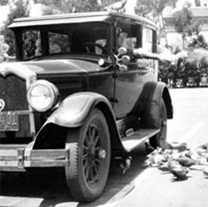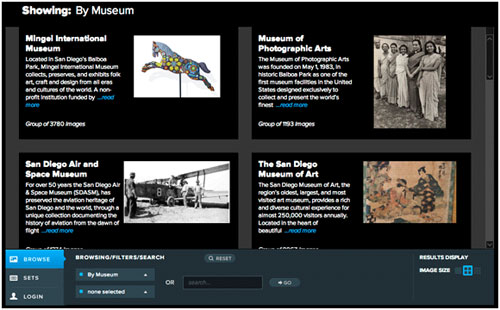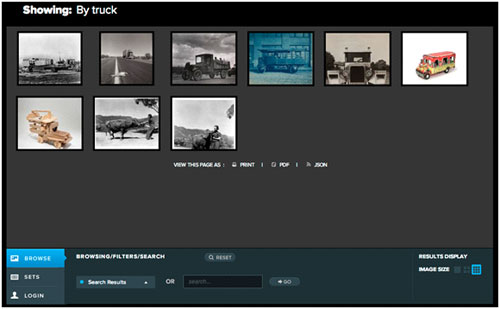 |
|
Grantee
Grant
Pictured |
|
Contact Website www.balboaparkcommons.org |
This May, the Balboa Park Online Collaborative (BPOC) launched the Balboa Park Commons, a resource for educators featuring over 20,000 digitized photographs and artifacts from seven cultural organizations in Balboa Park. The project was funded by a two-year IMLS National Leadership Grant and matched by the San Diego-based Legler Benbough Foundation.

The Balboa Park Commons currently features the Mingei International Museum, Museum of Photographic Arts,
San Diego Air & Space Museum, San Diego Museum of Man, San Diego Natural History Museum,
The San Diego Museum of Art, and Timken Museum of Art.
The Philosophy of Collaboration
With a focus on learning, the goal of the project was to provide the public with access to the rich collections that belong to the museums and cultural heritage organizations in the park. The project was the philosophical culmination of one of the founding goals of BPOC. Created in 2008 and comprising more than 20 organizational partners, BPOC supports the role of technology to achieve the missions of the park’s museums. Online access and collection management were identified as two of the strategic priorities for BPOC. The first step was for partner organizations to digitize their collections and implement collection management systems and best practices. Then to make the collections accessible to the public, BPOC worked with partners to publish their collections using social sharing tools such as Flickr Commons and YouTube.
The IMLS National Leadership Grant provided BPOC and the Balboa Park museums with funding to work collaboratively and innovatively on collection access. With the grant, the collaborative built a tool to aggregate the online collections of the San Diego museums. Inspired by Flickr Commons, this was designed to be a commons especially for Balboa Park with a focus on local San Diego history and culture.
Building a Commons with Students in Mind
To launch the commons project, BPOC first reached out to the community to ensure that the online portal would be useful to students and teachers. Local K-12 teachers, college professors, museum educators, and students participated in the planning and vision of the commons through a series of workshops. They asked for a tool that would make it easy for them to search, browse, and use materials in the classroom. They did not want prepackaged lesson plans. BPOC learned that teachers all use technology differently in the classroom and had divergent needs regarding topics of study and curricula. What was most important to the teachers was the ability to find images with little or no copyright restrictions.
The Building Blocks
After the workshops, the BPOC project team worked with the museums to select and implement a Digital Asset Management System (DAMS) to be the repository for the collection assets. The team decided to build the website user interface in a simple PHP web language which pulled directly from the DAMS. The goal was to build an interface that was sustainable and simple for museums to use. As museums put collections assets into the DAMS, they would be able to easily publish their collections to the commons website. For the next two years, the team used an iterative process of website design and software development and also implemented and deployed the back-end system.

Search Function, Balboa Park Commons
Features for Teachers and Learners of All Ages
The Balboa Park Commons makes it fun for visitors to search, browse, and make connections with these collections. Using the keyword search, visitors can find materials from multiple museums at one time. For example, a search for “horse” brings up 19th century photographs of horses from the Museum of Photographic Arts alongside images of carousel horses from the Mingei International Museum.
The commons also enables visitors to browse sets of images that the museums’ staff members have created. These are curated, thematic groups of images, e.g., “Asian Art.”
Visitors can also create and share their own sets. Sets of up to 12 images can be saved, shared via social media, and downloaded as PDF files or Powerpoint presentations.
A Creative Commons Non-Commercial license applies to all of the collections. This means that the materials can be downloaded and used for non-commercial educational purposes such as teaching, scholarship, research, criticism, and news reporting.
A tutorial video on YouTube provides step-by-step instructions for using the features of the online commons: http://ow.ly/kO8yP.
Lessons Learned
The biggest challenge for the collaborative was building the infrastructure to support a multi-institutional commons website while making design decisions about user interface. The team felt that it would have been easier to build the infrastructure, digitize the images, and implement the DAMS system first, and then start working on site design and experience. Early decisions about design and programming decisions drove major design and technical changes to the new infrastructure, which added more programming work and delayed the launch of the site considerably. However, the commons project was a major incentive for completing the infrastructure component and keeping the momentum going.
Another problem the team faced, which is common to large-scale website projects, was the rapid changes in technology. The BPOC judged that it was probably the best decision in the long run to build a simple PHP web interface that talks directly to the DAMS programming language. Yet the team recognized that using a web-based content-management system, such as Drupal or Word Press, would have made it easier to add new capabilities and functions. To add new features to the commons site going forward, the team will need to build them from scratch.
What’s Next?
Now that the site is launched, the team will work with San Diego teachers to evaluate it and see what’s working and what’s not. This feedback will help them plan and seek funding for additional features and content.
About the Author
Christina DePaolo is Director of Digital Media at the Balboa Park Online Collaborative (BPOC).